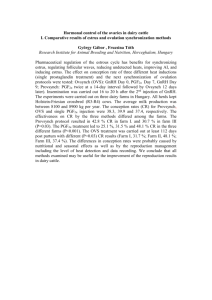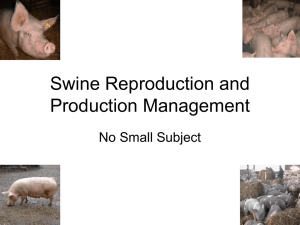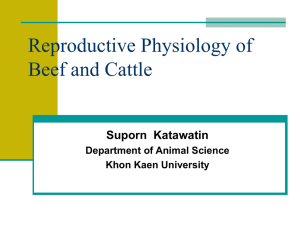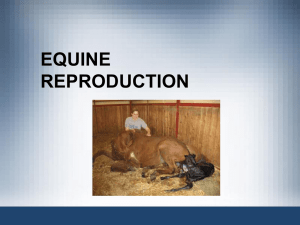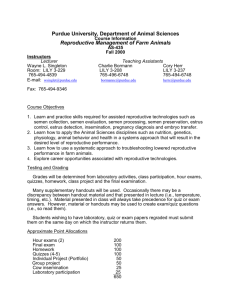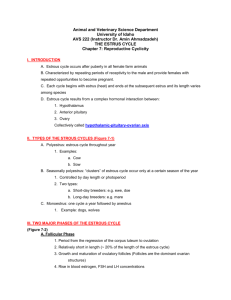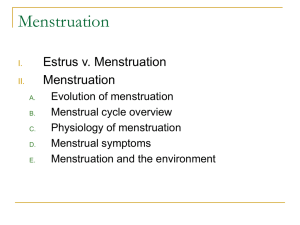Therio Exam Study Fall
advertisement
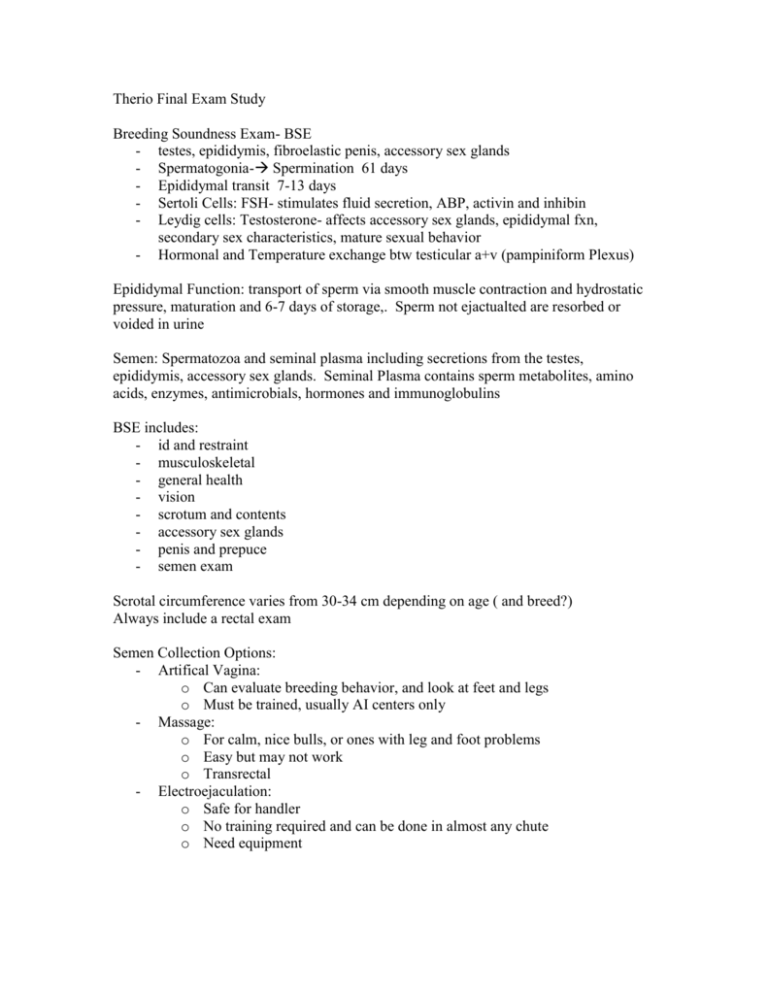
Therio Final Exam Study Breeding Soundness Exam- BSE - testes, epididymis, fibroelastic penis, accessory sex glands - Spermatogonia- Spermination 61 days - Epididymal transit 7-13 days - Sertoli Cells: FSH- stimulates fluid secretion, ABP, activin and inhibin - Leydig cells: Testosterone- affects accessory sex glands, epididymal fxn, secondary sex characteristics, mature sexual behavior - Hormonal and Temperature exchange btw testicular a+v (pampiniform Plexus) Epididymal Function: transport of sperm via smooth muscle contraction and hydrostatic pressure, maturation and 6-7 days of storage,. Sperm not ejactualted are resorbed or voided in urine Semen: Spermatozoa and seminal plasma including secretions from the testes, epididymis, accessory sex glands. Seminal Plasma contains sperm metabolites, amino acids, enzymes, antimicrobials, hormones and immunoglobulins BSE includes: - id and restraint - musculoskeletal - general health - vision - scrotum and contents - accessory sex glands - penis and prepuce - semen exam Scrotal circumference varies from 30-34 cm depending on age ( and breed?) Always include a rectal exam Semen Collection Options: - Artifical Vagina: o Can evaluate breeding behavior, and look at feet and legs o Must be trained, usually AI centers only - Massage: o For calm, nice bulls, or ones with leg and foot problems o Easy but may not work o Transrectal - Electroejaculation: o Safe for handler o No training required and can be done in almost any chute o Need equipment Semen Quality: (Ideals) - density and volume- creamy, 750- billion cells/ml - Gross Motility- rapid dark swirls - Individual Motility- 80-100% - Eosin negrosin stain or phase contrast to look at morphology- primary and secondary- count at least 100 cells, want at least 70% normal - Perform at 18 months age BSE Classification: -Satisfactory - Decision Deferred- usually young bulls, mature bulls following an injury or testicular insult, animals with a treatable injury - Unsatisfactory- poor fertility - BSE DOES NOT evaluate: Libido Serving ability Mating behavior Social interactions Bull Reproductive Disorders and Surgery Common Problems: 1. Phymosis; inability to extend penis a. Following injuries b. Stricture of prepuce c. Adhesions d. SX correction by resection and anastamosis 2. Preputial Lacerations and Prolapses a. Prepuce too long in polled breeds- predisposes them to prolapse b. Clean, protect, support tissue c. NSAIDS, antibiotics, hydrotherapy, sexual rest d. Following these problems, fibrosis and preputial stricture may occur and prevent extention of the penis- may be treated surgically E. Constable’s notes: Common in Brahman type cattle, b/c pendulous sheath, large preputial orfice, excessive prepuce, absence of retractor penis muscles (30% polled breeds lack muscle), swelling is centered on the ventral 1/3 to ½ of the sheath, Called a complex b/c frequently becomes infected 1. with prolapse 2. with phimosis 3. with paraphimosis 4. with abcessation Treatment: clean prepuce an dflush with saline until runs clear, correct prolapse if present and put a 6”garden hose into preputial orfice and tape into place, hydrotherapy daily and Epsom salt soak with decrease edema, apply “Petermycin” ointment (lanolin, tetracycline, scarlet oil), antibiotics, banamine as needed, sex rest, resect an dremodel scar or circumcise bull if needed following healing 3. Paraphimosis; inability to retract the penis a. Treat as for preputial lacerations b. Return penis to normal position ASAP c. Fair to poor prognosis 4. Fibropapillomatosis; warts a. Viral, on glans portion of the penis b. Young bulls housed together c. Signs- reluctant to breed, phymosis, paraphimosis d. Rx- spontaneous regression, SX removal, freezing, vaccinate 5. Persistant Penile Frenulum; failure of complete separation btw penis and prepuce a. Congenital problem b. Signs- ventral deviation of penis, reluctance to breed c. Rx- SX with local anesthesia, ligate vessels as needed 6. Hair Rings; a. Congenital b. Discomfort, necrosis c. Rx- remove hair ring, wound therapy 7. Inflammation a. Young bulls associated with abrasions (BHV-1) b. Discomfort, small areas of focal necrosis, adhesions c. Rx- self limiting, wound therapy, sexual rest 8. Penile Deviation; S or spiral a. Apical ligament problem b. May interefere with breeding c. Rx- SX ($$), fixation of apical ligament, sex rest, cull 9. Penile Hematoma (hematoma- horned, preputial- polled) a. Tear on the tunica albuginea, dorsal surface of the penis b. Rupture of the tunica albuginea, escape of blood from the CCP (?Corpus Cavernosum?) of erect penis due to penile misdirection (miss vulva)always blow out on the DORSAL surface of the DISTAL sigmoid flexureopposite the retractor penis muscle c. Ventral penile deviation during mating d. Swelling cranial to scrotum, preputial swelling and prolapse, adhesions, desensitization of the glans penis e. Rx- antibiotics (not very effective), Sx if larger than a grapefruit- general anesthesia lateral recumbancy- gently remove clot and only remove a clot that wants to be removed. (within 7 days), sex rest 60-90 days but place bulls across fence from cycling females after 10 days to help decrease adhesion formation 10. Seminal vesiculitis a. Frequent b. Young bulls on a high energy diet c. Viral (BHV-1) or Bacterial (B. abortus, H. pyogenes, H.somnus) d. Signs- enlarged seminal vesicles, painful and firm, adhesions, abcesses, WBC’s in semen e. Rx- Antibiotics (not very effective), SX, cull 11. Epididymitis a. Swelling, warmth, pain b. Scar, trauma, infection c. Cicatrix formation (the fiberous tissue left after healing of a wound; scar) cystic dilatation of the epididymis with content accumulation-limits resorbtive abilites degenerationspermatocelespermatic granuloma d. Rx- symptomatic, cull 12. Orchitis/ Testicular degeneration a. Wounds, bacteria (B. abortus, A.pyogenes) b. Heat stress c. Swelling, pain d. Tunica albuginea is inelastic pressure necrosistesticular degeneration e. Rx- remove insult, cold hydrotherapy, hemicastration, degeneration of contralateral testes, reevaluate in 2 months 13. Testicular Hypoplasia (one or both testes affected) a. MOST COMMON reproductive abnormality b. Possibly congenital? c. Low sperm concentration, motility and morphology may be normal d. Subfertile to infertile e. Sperm count lower than recommended by SFT f. Rx: Cull 14. Cryptorchid a. Uncommon, inherited, cull Surgeries: 1. Castration a. Most common bovine SX performed, unilateral or bilateral b. Anesthesia- none, lidocaine for analgesia (nice fucking protocol) c. <3 months old d. closed or open technique 1. Burdizzo (emasculotome- avascular necrosis of testes) 2. Lactic acid- Chemcast (Chemical NOT RECOMMENDED) 3. Rubber bands(Elastrator band- avascular necrosis of testes)- increased risk of tetanus compared to SX castration, can be done during fly season 4. Castration knife 5. Scapel Blade (if <3 months, tear tissue, if > 3months apply emasculator for 1-2 minutes 6. Emasculator 7. immunization against Tetanus 8. antibiotics are not usually indicated 2.Tumor Removal e. Tamassia- no tranquilization, local on dorsal penile nerves, tourniquet, ligate stalk and remove tumor f. Constable- light tranquilization, pudendal nerve block, remove tumor using scapel +/- electrocautery for hemostasis, close mucosa with 2/O Vicryl and sexual rest for 60 days 3.Penile Deviation SX- see previous notes 4.Penile Hematoma- see previous notes 5.Teaser Bull 1. Tamassia: a. Very efficient estrus dectector b. Techniques that allow intromission: - Vasectomy (recommended) - Epididyectomy - Preputial pouch formation c. Techniques that prevent intromission- “frustration factor” - penile deviation - animals may learn how to breed - penile and prepuce fixation 2. Constable: a. 3 main objectives of SX i. render animal sterile ii. prevent intromission and transmission of veneral dz iii. to maintain libido b. Penile translocation- best option b/c libido still good, no intromission, still can get an erection and extension, most $ and hard to perform c. Penopexy:- penis sutured to midline- easier to perform, decreased libido d. Phallaectomy- perineal incision is made, the penis is transected and sutured to the perineum, easier to perform, decreased libido e. Preputial stenosis- steel ring surgically placed and a preputial fistula is produced on the ventral aspect of the sheath- blind pouch that prevents extrusion of penis but allows for urine drainage f. Vasectomy and Caudal epididmyeactomy- most simple to perform, does not prevent intromission so not as favored over other techniques Infectious Causes of Infertility and Abortion in Cattle 1. Trichomoniasis- true veneral dz of cattle- Trichomonas foetus i. Signs: infertility, long interservice interval, post coital pyometra, abortion in 1st ½ of gestation ii. Can have asymptomatic male carriers iii. Pathophysiology- transient infection of young bulls, transmitted at breeding and organism attacks embryo (vaginitis, cervicitis, endometritis, placentitis) iv. Females may develop immunity and conceive, males do not gain immunity v. Diagnosis- virgin test heifer mating (sounds real fucking smart) and culture, serology is apparently not practical, or you can isolate the organism from smegma or vaginal mucous vi. Treatment- topical imidazoles but it’s not allowed vii. Control- AI, cull open cows, breed with virgins, vaccinate before breeding, short breeding season, test bulls first 3. Campylobacterosis- true veneral dz of cattle i. Campylobacter fetus ss veneralis ii. Signs- infertility (prolonged cycle-2-3 mo), abortion at 4-7 mo iii. Diagnosis- isolate organism from smegma, fetal abomasal contents, vaginal mucous iv. Pathophysiology- transmitted at breedig and organism attacks fetus, females develop immunity and conceive v. Control- AI, oil adjuvinated vaccine prior to breeding vi. Treatment- Male- Dihydrostreptomycin SC or lavage, ointmentneomycin or erythromycin 4. Listeria Monocytogenes i. Encephalitis, neonatal septicemia, abortion ii. Sporadic cases or outbreaks iii. 3rd trimester abortions iv. associated with poor quality silage v. oral exposure hematogenous spread to the fetus with placentitis and septicemia vi. Diagnosis- isolate organism from aborted fetus, retained fetal membranes, and look for signs of endometritis, fever, neutropenia, weight loss vii. Treatment and control- avoid exposure, good silage, remove aborted fetus and segregate affected cows- vaginal discharge can be infective for 1 month viii. ZOONOTIC DISEASE 5. Haemophilus Somnus i. Complex disease with CNS signs, polyarthritis, respiratory disease, repro tract infection, abortion ii. Suggested to cause infertility by affecting the ZP iii. Common inhabitant of the male and female repro tracts iv. Pathogenesis- abortion secondary to hematogenous spread , thrombotic pneumonia and placental necrosis v. Diagnosis- isolate organism in pure culture, paired serology vi. Treatment/ Control- vaccinate, susceptible to most Antibiotics 6. Brucella abortus i. Abortion in the last ½ of gestation ii. animals permanently infected, spread by ingestionbacteriemia uterus iii. state and federal control program iv. uterine discharge is infectious 15-21 days v. Signs- abortion, retained placenta, metritis vi. Treatment and control- vaccinate heifers, test and slaughter, do not buy/sell untested cattle vii. ZOONOTIC DISEASE; milk and aborted fetus 7. Leptospirosis i. Leptospira interrogans- many serovars- Hardjo (bovine), Pomona (swine), Grippotyphosa ii. Cattle are incidental hosts – ability to penetrate mm’s iii. Survives long time in environment, high pathogenicity, acute dz iv. Abortion form mid-gestation to term (4-12 weeks) after infection v. **Leptospira bogpetersenii serovar hardjo-bovis 1. host maintenance relationship with cattle- low pathogenicity and chronic dz 2. infertility may follow localization of hardjo in oviduct and uterus 3. abortion at all stages and Early Embryonic Death 4. Pathogenesis- Leptospiremia, organism localizes in genital tract and kidney, shed in urine and uterine discharge 5. Diagnosis- demonstrate organism in fetal tissues, seroconversion- Dam’s titer is stable or falling at time of abortion, vaccinal titers complicate interpretation, L.hardjo is weakly antigenic 6. Treatment and Control- prevent contact with contaminated surface water, increase herd immunity, reduce exposure a. Host adapted- multivalent bacterin(vacc doesn’t prevent infection), vaccinate at mid gestation (short duration of immunity and dairy herds may require multiple vacc’s each year b. Non- Host Adapted- organism maintained by nondomestic species, so control rodents and wildlife ZOONOTIC DISEASE 8. Granular vulvitis a. Ureaplasma diversum, Mycoplasma spp, Haemoplilus somnus b. Sporatic cause of abortion in cattle c. Salpingitis, cervicitis, endometritis d. Associated with infertility- can be isolated from the tracts of healthy cows so be sure to prevent transmission into uterus during breeding, feed oxytet before and during breeding season, and I gram of tetracycline IU @24hrs post breeding 9. Neospora canium a. Neosporisis- abportion form 3mo to the end of the gestation period with most occurring at 5-6 months b. Mummification, stillborn, alive but dz, or born clinically normal but chronically infected c. Protozoan parasite d. Definitive host = dog e. Intermediate hosts- dogs, cattle, sheep, goats, deer and horses f. Dairy and beef cattle affected worldwide- major cause of abortion(some herds 100% seropositive) g. Signs- abortion at 5-6 mo, abnormal neonate (neuro signs, hyperflexion/extention, ataxia, asymmetrical eyes) h. Transmission- Vertical- congenitally infected heifers (minimal horizontal transmission) i. Diagnosis- maternal serology indicates exposure, submit entire fetusbrain, heart, liver- and demonstrate organism in tissues j. Prevention- cull seropositive animals, protect feed from contamination, keep dogs away from aborted fetuses, vaccine available with unproven efficacy, no drugs that can prevent transmission from dam to fetus 10. Chalamydia psittaci a. Associated with late term abortions, still births and weak calves b. Diagnosis- demonstrate organism in placenta or fetal liver c. Treatment- no vaccine approved for cattle, susceptible to tetracycline 11. Mycotic Abortion: Aspergillus fumigatus and others a. Sporatic abortions usually at 6-8 mo b. Organism enters thru GI or resp tract i. Confinement and low quality feed c. Signs- severe placentitis , fetal dermatitis d. Pathogenesis- hematogenous spread to placentaplacemtomesinetercotiledonary area e. Diagnosis- demonstrate fungal hyphae, isolate organism, contaminates may confuse results f. Control- improve management, avoid moldy feed, hay, silage Hormone Therapy 1. Steroid Hormones a. Progesterones b. androgens c. estrogens d. corticosteroids *Sources- testes, ovaries, adrenals, placenta, fetal gonads, bottle Estrogen 1. Actions a. Stimulate signs of estrus b. Stim myometrial contractions c. Leutolytic action (early and late in cycle) d. Delay oviduct transport (72hrs post ovulation) e. Induce abortion- up to 5mo Pharmaceuticals 1. no parenteral products approved 2. Premarin (causes death of 50,000 foals per year- like Snapple above)- Estrone Sulfate 3. Diethylstibestrol 4. Implants 5. ECP Progesterone: 1. Actions: a. Blocks behavioral estrus b. Synchronize estrus c. Support pregnancy d. Suppress myometrial activity e. Behavior modification 2. Source a. Ovaries b. Placenta c. Fetal Gonads d. Bottle i. Melengestrol acetate (MGA)- feed additive ii. Megestrol Acetate- Ovaban iii. Altrenogest- Regumate iv. Matrix 1. Progesterone inoil 2. medroxyprogesterone acetate- Provera, Depoprovera 3. growth promoting implants 4. Intravaginal devices (CIDR) Androgens: 1. Actions: a. Suppress estrus b. Improves athletic performance c. Promote growth d. Estrus detection in animals 2. Pharmaceuticals: a. Androgens are Schedule III drugs b. Injectable c. Implants- growth promotion d. Aerosol- SOA, synthetic boar odor Corticosteroids: 1. Actions: a. Induced parturition/ abortion in ruminants 2. Pharm’s a. 16 alpha- substituted synthetic steroids i. Dexamethasone ii. Flumethasone iii. Triamcinolone Protein Hormones: 1. LH 2. FSH 3. eCG 4. hCG Sources: 1. pituitary- LH and FSH 2. placenta 3. bottle (are you noticing the trend at all?) Luteinizing Hormone 1. stimulates androgens secretion Leydig and Thecal cells 2. stimulates progesterone secretion (luteal cells) 3. Ovulation of mature follicles 4. corpus luteum formation and maintenance --Pharmaceuticals: 1. only research products 2. hCG has LH-like action 3. GnRH induces endogenous LH release Follicle Stimulating Hormone (FSH) 1. stimulates follicular growth, spermatogenesis and estrogen production 2. superovulates embryo donors (ruminant and swine) --Pharmaceuticals: 1. Pituitary extract (Folltropin-V) Human Chorionic Gonadotropin 1. recognition of pregnancy and maintenance of luteal secretion 2. LH like activity in animals 3. luteinize ovarian cysts 4. induce ovulation 5. stimulates secretion of testosterone 6. long t1/2 Pharmaceuticals: 1. Chorlon, Follutein Equine Chorionic Gonadotropin 1. FSH like activity in animals 2. superovulation of embryo donors 3. out of season breeding- sheep and goats Pharmaceuticals: 1. PG-600 (hCG and eCG) Gonadotropin Releasing hormone: 1. synthesized in the hypothalamus 2. stimulates release of endogenous FSH and LH a. induce ovulation of mature ovarian follicles Oxytocin: 1. 2. 3. 4. 5. milk let down myometrial contractions Parturition Uterine involution and expulsion of retained placenta estrogens stimulates oxytocin receptors Pharmaceuticals: 1. injectable- 20 units/ml Prostaglandins: 1. induces regression of the mature corpus luteum a. manipulation of the estrous cycle b. induced abortion/ parturition c. pyometra Pharmaceuticals: 1. Dinoprost (Lutalyse, ProstaMate) 2. Cloprostenol (Estrumate) Immunological Control of Reproduction 1. Porcine zona pelucida (pZP) vaccine a. AntiZP antibodies block fertilization 2. AntiGnRH vaccine- GnRH agonist Neutersol 1. Zinc gluconate/ arginine 2. Intratesticular injection a. Sterilization of puppies at 3-10 months old 3. Dose is based on testicular size 4. Testosterone concentrations drop to about 50% of those prior to tx Manipulation of the Estrous Cycle 1. reasons a. AI- embryo transfer b. Management procedures c. Convenience d. Fertility control e. Cost to the producer 2. Options a. Shorten luteal phase b. Lengthen luteal phase i. New CL ii. Artifical CL Drugs to Control the bovine estrous Cycle 1. Prostaglandin F2alpha (PGF) a. Luteolysis of mature corpus luteum b. Return to estrus in 2-5 days 2. Gonadotropin releasing hormone (GnRH) a. Induces ovulation of a dominant follicle b. Ovulation is followed by emergence of a new follicular wave 3. Progesterone a. Works as an artifical CL Prostaglandin F2alpha 1. Lysis of corpus luteum btw days 5-7 and 17 2. estrus 2 to 5 days after treatment (av=day 3) 3. Cows must be cycling a. Corpus luteum is required for response b. Adequate nutrition c. Adequate postpartum interval Weekly PGF Injections 1. Inject all eligible cows each week a. Concentrate estrus detection at convenient time i. Inject on Monday, detect estrus on Wednesday, Thursday and Friday ii. Inject on Wednesday, detect estrus on Friday, Saturday and Sunday b. Single Injection i. Inject all cows with PGF, detect estrus and inseminate ii. Should synchronize about 70% c. Two injections, 11 day interval i. Detect estrus and inseminate after second injection ii. Should synchronize about 100% Targeted Breeding 1. Establish a voluntary waiting period (45-60 days) 2. “set up” injection of PGF 14 days before end of VWP (Monday) 3. “Breeding” injection of PGF 14 days later (Monday) 4. Detect estrus and inseminate on Wednesday, Thursday and Friday 5. 14 Days later, PGF to cows not seen in estrus 6. Breed 80 hours after 3rd injection if not seen in estrus 7. examine for pregnancy <35 days after AI 8. Return nonpregnant cows to PGF injection schedule 9. requires accurate records and attention to detail 10. estrus detection confined to 3 days/2 weeks Modified Targeted Breeding 1. Set up injection of PGF 14 days before end of VWP 2. Day 14- GnRH 3. Day 21- PGF 4. Observe for estrus or breed at 72 hours to 80 hours Progestins 1. Artificially prolong the estrous cycle a. Progestin suppresses gonadotropins, ovulation, behavioral estrus b. Abrupt termination mimics regression of the CL 2. Progesterone induces puberty in heifers and cyclicity in postpartum cows Melengestrol Acetate (MGA) 1. Orally active progestin—feed additive 2. Feed MGA for 14 days 3. Give PGF 17-19 days after the end of MGA 4. Detect estrus and inseminate Modified MGA 1. Days 0-14—Feed MGA 2. Day 26—GnRH; induce ovulation, initiate new follicular wave 3. Day 33—(19 days after end of MGA)- PGF 4. Detect estrus and breed Ovsynch: GnRH and PGF 1. Start 10 days prior to AI 2. Day 0- GnRH, induces ovulation of the dominant follicle, formation of a new wave of follicles 3. Day 7- PGF, induces regression of the CL 4. Day 9-(30-90 hours) GnRH, ovulation of the new dominant follicle 5. Breed 16 hours after 2nd GnRH (no estrus detection) 6. Examine for pregnancy at 28 to 35 Days after AI Pre Synch 1. 2. 3. 4. 5. Day 0- PGF Day 14- PGF Day 28- GnRH Day 35- PGF Day 37- GnRH 6. Day 38- AI (8-16 hours after GnRH) 7. no estrus detection Select Synch 1. Day 0-GnRH; ovulate dominant follicle 2. Day 7- PGF; regress CL formed by last ovulation 3. Estrus detection begins 3 days before PGF and continues through day 5 after PGF Co-Synch 1. Day 0(AM) GnRH;ovulate dominant follicle 2. Day 7(PM) PGF; regress CL 3. Day 9-(PM) GnRH and AI (no estrus detection) 7-11 Synch 1. MGA fed for 7 days 2. PGF on the last day of feeding MGA 3. GnRH 4 days after the end of MGA 4. PGF 11 days after end of MGA 5. Detect estrus and AI 6. Most cows in estrus 42-66 hrs after PGF CIDR - insert into vagina and leave for 7 days Give PGF2alpha on day 6 (1 day prior to removal) Remove CIDR on day 7 Detect estrus and breed after removal – most will be in estrus 1-3 days after removal Estrus Suppression - MGA commonly added to ration for feedlot heifers - Ovariectomy o Cost may not be justified for feedlot heifers o Estrus control for pet cows Summary: - Create your own protocol (free the cows), call it any name that you want (Heifer Heaven), as long as it is physiologically sound you will have acceptable pregnancy rates - Pregnancy rates will be higher (independent of protocol, other than Heifer Heaven), if cows are bred in observed estrus - Nutrition, age, milk production, suckling, management, stress, can all influence success rate Assisted Reproductive techniques: AI and ET Advantages of AI - increased use of superior sires- genetic progress - eliminate dander and expense of maintaining a male - increase the number of available bulls- cheaper than buying the bull, satisfactory pregnancy - Reduced transmission of veneral dz - Offspring from males that are unable to copulate - Inseminate females that are unwilling to copulate Reasons to use assisted reproduction - Average cow: one calf/yr- bull breeding - Genetic improvement- AI - Better exploit the cow’s genetic potential - Increase the number of calves from superior females Disadvantages of AI - Trained technicians required - Need to observe heat - Rapid spread of genetic abnormalities Hyperkalemic periodic paralysis (horses)- HYPP (impressive) Bovine Artifical Insemination - semen collection o artifical vagina o electroejaculation - Packages o Straws o Ampules o Pellets Semen collection semen analysis DILUTION Freezing - insemination dose is 6-10 million motile sperm after freezing and thawing store and ship in LN2 o Maintain liquid nitrogen level o Do not raise canisters above the neck of the refrigerator - Semen tank management: o Extremely efficient- up to 9 mo o 2 chambers o not airtight o proper maintence and storage o transport with care o keep inventory o Frost or “sweating” can not keep semen frozen in regular freezer- min temp -100 C Thawing semen - follow processors directions - straws thawed in warm water o 35-37 C o avoid thawing more than 2 straws simultaneously o Dry thoroughly (water is spermicidal) o Check accuracy of thermometer Technique : - Cut crimped end of straw position straw, protect from cold (stick it down your pants or up your butt) - Pass insemination gun thru cervix- stabilize cervix per rectum, gentle to avoid trauma - Deposit semen in uterine body- body vrs horn insemination Infertility associated with AI - Semen quality- return to processor for evaluation if possible - Thawing technique- air thaw, in cow thaw, bad thermometer, or thaw too many simultaneously - Technician error- horn bleeding, splitting straws - Estrus detection- inseminate cows that are pregnante or not in estrus Embryo Transfer - Why? o Increase number of offspring from superior females o Better use of rare or $$ semen o Speed up genetic improvement (or narrow it down till we’re fucked) o Prevents Dz transmission o Salvage reproduction- not the ideal donor o Cryopreservation, rare breeds o Research tool Donor Cow - superior genetics - commercial value - good health - free of diseases - more than 60 days postpartum - fertile - good BSE - good maternal ability Superovulation treatment - stimulation of follicular growth- 4 day tx Synchronizing ovulations Insemination (on the 5th day/2-3 AI) Flush Embryo search and grading Transfer Embryo Flush and Transfer - Clean, avoid contamination - Epidural - Catheters- 2 or 3 way - Horn or body flush - Flush solution- saline, serum, BSA Stages of embryo development (1-9) 1. unfertilized 2. 2-12 cell 3. early morula 4. morula 5. early blastocyst 6. blastocyst 7. expanded blastocyst 8. hatched blastocyst 9. expanded hatched blastocyst Embryo Quality Grades 1. Excellent or good-(may not be culled until it’s 4 years old!!!) 2. fair- (likely cull) 3. poor- (should probably call up the cull factory and have them ready) 4. dead or degenerating- (at least you don’t have to pay the culler) Results: Large Variability - Superovulation- 12 ovulations (0- >50) - Flush- recovery rate 15-80%, 6-9 embryos - Search- Transferable embryos 0-100%, 5-6 embryos - Gestation- preg rate 50-60% 3 calves Disadvantages - increased expenses and higher breakeven costs for calves - requires a higher level of management - increased potential for spread of certain diseases - not all potential donors respond positively to treatment Factors affecting embryo production - bull - donor cow- age, breed, genetics, milk prod, fertility, health - environment- underfed, overfed, season, stress treatment- hormones, intervals, suckling Factors affecting pregnancy rate - embryo- quality, freezing method - operator - environment- nutrition, BSC, stress - Recipient- age, fertility, stress Freezing embryos: - storage at 5 C - cooling embryos- water crystal formation - freezing on glycerol or ethylene glycol - transport - Cytoprotectants- lower freezing pt, help dehydrate embryo, protection to embryonic membranes, protect from high osmotic pressure - Freezing Curve- seeding, slow freezing to remove more water - Freezing solutions- quick thaw or glycerol - Handle with care - Embryo freezer - Storage space - Follow thawing instructions Cotton plug Air Embryo with cytoprotector Plug
